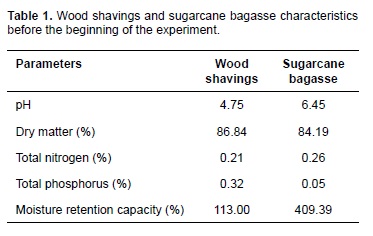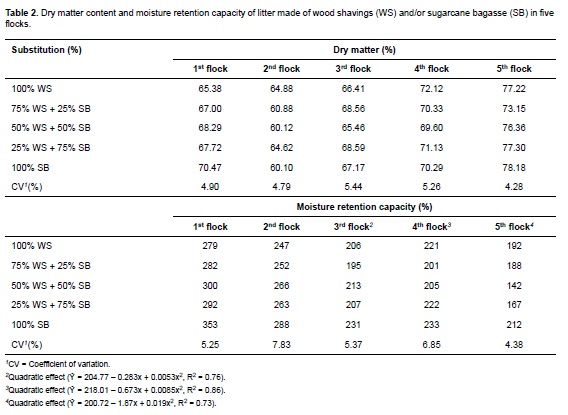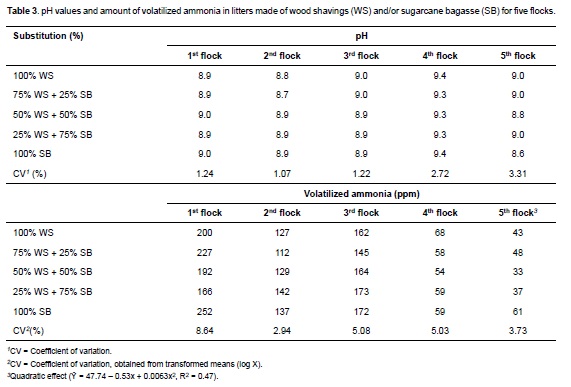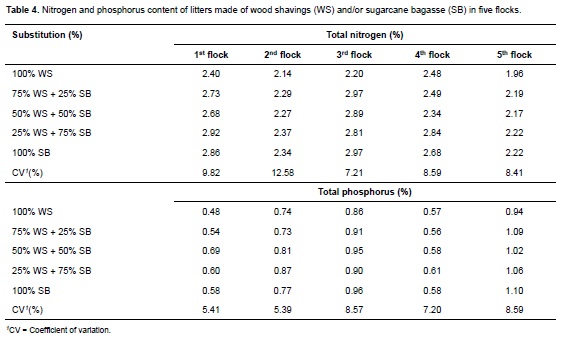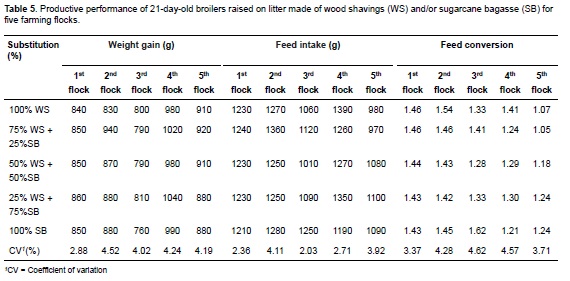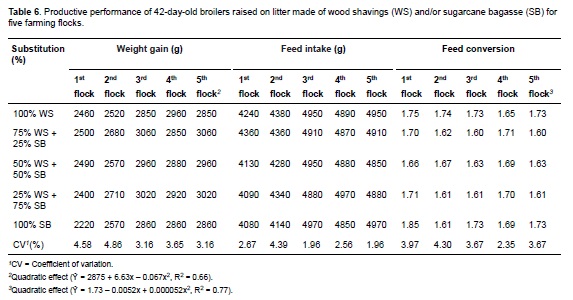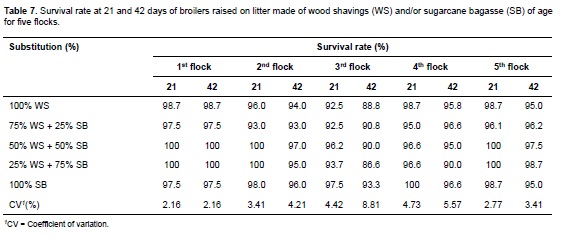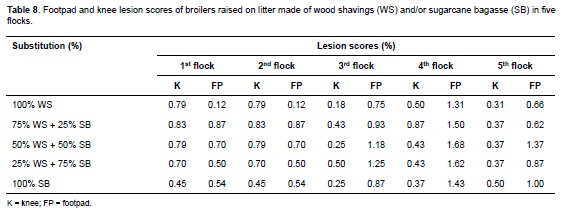Services on Demand
Journal
Article
Indicators
-
 Cited by SciELO
Cited by SciELO -
 Access statistics
Access statistics
Related links
-
 Cited by Google
Cited by Google -
 Similars in
SciELO
Similars in
SciELO -
 Similars in Google
Similars in Google
Share
Revista Colombiana de Ciencias Pecuarias
Print version ISSN 0120-0690
Rev Colom Cienc Pecua vol.28 no.3 Medellín July/Aug. 2015
https://doi.org/10.17533/udea.rccp.v28n3a4
ORIGINAL ARTICLE
doi: 10.17533/udea.rccp.v28n3a4
Poultry litter of wood shavings and/or sugarcane bagasse: animal performance and bed quality¤
Cama de viruta de madera y/o bagazo de caña de azúcar para pollo: desempeño animal y calidad de la cama
Cama composta por maravalha e/ou bagaço de cana de açúcar para frangos: desempenho animal e qualidade da cama
Adriely S Teixeira1, MV, MSc; Maria C de Oliveira2*, MV, PhD; June F Menezes3, Agr, PhD; Bruno M Gouvea2, Grad; Sonia R Teixeira1, MV, MSc; Alex R Gomes4, Bio.
1Instituto Federal Goiano, Rio Verde, GO, Brasil.
2Faculdade de Medicina Veterinária, Universidade de Rio Verde e IF Goiano, Rio Verde, GO, Brasil.
3Faculdade de Agronomia, Universidade de Rio Verde, Rio Verde, GO, Brasil.
4Faculdade de Biologia, Universidade de Rio Verde, Rio Verde, GO, Brasil.
*Corresponding author: Maria Cristina de Oliveira. Faculty of Veterinary Medicine, University of Rio Verde, Rio Verde, 75901-910, Brazil. Tel: 55-64-3611- 2217. Fax: 55-64-3620-2201. Email: mcorv@ig.com.br
Received: July 16, 2014; accepted: November 12, 2014
Summary
Background: litter provides comfort to animals while improving productive performance and carcass quality. Objective: this study evaluated broiler performance, incidence of contact dermatitis, and quality of poultry litter of wood shavings and/or sugarcane bagasse (SB) after five consecutive flocks. Methods: two thousand birds were raised in five consecutive flocks composed of 400 chicks each. The experiment was set in a completely randomized design with five treatments and four repetitions. The treatments consisted of substituting wood shavings with different levels of SB (0, 25, 50, 75, and 100%). Results: litter density, pH, dry matter content, total nitrogen, and phosphorus did not vary between treatments. However, substituting wood shavings with SB increased moisture retention capacity of the litter and ammonia production. Neither carcass lesions nor productive performance, with the exception of weight gain and feed conversion ratio in the fifth flock, differed between treatments. Conclusions: substituting 75% of wood shavings with SB maintained litter quality and improved poultry performance.
Keywords: ammonia volatilization, carcass grading, carcass quality, poultry carcass, poultry manure, sugarcane byproducts.
Resumen
Antecedentes: la cama propicia el confort y mejora el desempeño productivo y la calidad de la canal de los pollos de engorde. Objetivo: el objetivo del presente estudio fue evaluar el desempeño productivo de pollos de engorde, la incidencia de dermatitis de contacto en la canal y la calidad de la cama de pollo compuesta de viruta de madera y/o bagazo de caña de azúcar (SB), usada en cinco lotes consecutivos. Métodos: dos mil aves fueron criadas en cinco lotes consecutivos, cada uno constituido por 400 pollitos, en un diseño completamente aleatorizado con cinco tratamientos y cuatro repeticiones. Los tratamientos consistieron en diferentes niveles de sustitución de viruta de madera con SB (0, 25, 50, 75 y 100%). Resultados: la densidad, pH y contenidos de materia seca, nitrógeno total y fósforo no variaron entre los tratamientos. Sin embargo, sustituir viruta de madera con SB aumentó la capacidad de retención de humedad y la cantidad de amoníaco volatilizado en el galpón. Ni las lesiones en la canal y ni el desempeño productivo, con excepción de la ganancia de peso y conversión alimentaria en el quinto lote, difirieron entre los tratamientos. Conclusiones: sustituir 75% de la viruta de madera con SB mantuvo la calidad de la cama y mejoró el desempeño productivo de las aves.
Palabras clave: calidad de canales, canales de aves de corral, clasificación de la carcasa, estiércol de las aves de corral, subproductos de la caña de azúcar, volatilización de amoníaco.
Resumo
Antecedentes: cama de frango propicia conforto e melhora o desempenho produtivo e a qualidade da carcaça das aves. Objetivo: este estudo avaliou o desempenho produtivo de frangos de corte, a incidência de dermatite de contato na carcaça e a qualidade da cama de frango composta de maravalha e/ou bagaço de cana (SB), usada em cinco lotes consecutivos. Métodos: duas mil aves foram criadas em cinco lotes consecutivos, compostos de 400 pintinhos cada, em delineamento inteiramente casualizado com cinco tratamentos e quatro repetições. Os tratamentos consistiram de diferentes níveis de substituição de maravalha com BC (0, 25, 50, 75 e 100%). Resultados: densidade, pH e teores de matéria seca, nitrogênio total e fósforo não variaram entre os tratamentos. Entretanto, substituir maravalha com SB aumentou a capacidade de retenção de umidade e a quantidade de amônia volatilizada no galpão. Nem as lesões na carcaça e nem o desempenho produtivo, com exceção do ganho de peso e conversão alimentar no quinto lote, diferiram entre os tratamentos. Conclusões: substituir 75% da maravalha com SB manteve a qualidade da cama e melhorou o desempenho produtivo das aves.
Palavras chave: cama de frango, classificação de carcaça, qualidade de carcaça, carcaça de frangos, subprodutos da cana de açúcar, volatilização de amônia.
Introduction
Poultry bedding provides comfort and decreases the incidence of dermatitis on the breast, knee, and footpad, while increasing performance and carcass quality of broilers. Bedding can be made of a variety of materials; wood shavings are the most commonly used substrate. However, wood shavings are not always readily available and can be more costly, as they are usually transported from other regions (Araújo et al., 2007). In some regions of Brazil, sugarcane bagasse (SB), a byproduct of alcohol production, is more readily available and costs less than wood shavings.
It is essential to control the litter humidity; otherwise it may become caked, slippery, and sticky if it is too moist. According to Butcher and Miles (2012), if the litter is not maintained with low moisture, bacterial growth, odors (including that of ammonia), fly proliferation, dirty feathers, and lesions on the footpad and breast will develop.
Litter pH is also important, as high pH levels result in greater concentrations of ammonia. The release of ammonia from the litter is higher with increasing pH, moisture content, and temperature (Miragliotta et al., 2002). The type of litter material and litter handling can also influence ammonia release (Sampaio et al., 1999). While poultry litter is a valuable fertilizer for several crops, its usefulness can be reduced if significant nitrogen loss from ammonia volatilization occurs (Lovanh et al., 2007).
Contact dermatitis can affect breast, knees, and footpads of broilers. Footpad dermatitis (FD) is a critical problem that can compromise exports of chicken feet and legs (Hashimoto et al., 2013). This condition can also affect breast and knees.
This study was conducted in five consecutive flocks to evaluate the effect of poultry litter made of wood shavings and/or SB on litter quality, broiler performance, incidence of contact dermatitis on the carcass, and economic viability of these bedding materials.
Material and methods
This study was approved by the Animal Ethics Committee of Rio Verde University (number 02/11, April 19, 2012).
Two thousand birds were raised in five consecutive flocks, each composed of 400 one-day-old male Cobb chicks. Masonry boxes measuring 1.52 m2 housed twenty birds each. The mean initial weight of birds was 49.63 ± 0.89 g, 52.50 ± 0.7 g, 54.63 ± 0.89 g, 48.00 ± 0.9 1g, and 49.60 ± 0.20 g for the first, second, third, fourth, and fifth flock, respectively. The mean temperature and relative humidity (RH) of the air during the trial in the first, second, third, fourth, and fifth flocks were 24.3 °C and 68%, 23.7 °C and 80%, 25.0 °C and 71%, 22.3 ºC and 70.8%, and 21.5 °C and 55%, respectively.
The experiment was carried out using a completely randomized design, with five treatments and four repetitions. The treatments were composed of different levels of substitution of wood shavings with SB: T1) 0% SB and 100% wood shavings; T2) 25% SB and 75% wood shavings; T3) 50% SB and 50% wood shavings; T4) 75% SB and 25% wood shavings; T5) 100% SB and 0% wood shavings. Bedding materials were placed to a depth of 15 cm in each box before the first flock started. Initial characteristics of each material are shown in Table 1, and were determined as described by Silva and Queiroz (2002) and Oliveira et al. (2002).
The flocks were established 15 days apart. After each flock was cleared, feathers were burned with a blowtorch and the litter was upturned to reduce moisture content. During this period, the shed curtains were kept open during the day to provide better air circulation. Heat was provided by electric lamps with 60 W light bulbs during the first 14 days.
A 24-h light program that incorporated natural and artificial lighting was used. Feed and water were offered ad libitum for the entire trial. Animals were fed commercial feed, divided into five categories: prestarter (1-9 days), starter (10-18 days), grower I (19-25 days), grower II (26-34 days), and finisher (35-42 days). The feed and the birds were weighed at the beginning of the trial, and at 21 and 42 days to evaluate body weight, weight gain, feed intake, and feed conversion ratio. Survival rate of the birds was also calculated by recording bird mortality at 21 and 42 days.
At the end of each flock, two birds from each box were slaughtered after 12 h of fasting. After the birds were plucked, lesions on their breasts, knees, and footpads were examined. Two evaluators performed subjective assessment of these lesions. Scores described by McWard and Taylor (2000) for knee and footpad lesions were used for dermatitis analysis.
Litter samples were collected on the 42nd day of the experiment from six different sites per box (avoiding areas close to the feeders and drinking fountains) from each flock. After collection, samples were homogenized, placed in labeled plastic bags, and taken to the laboratory for analysis of pH, dry matter (DM) content, total nitrogen (N) content, phosphorus (P) content (Silva and Queiroz, 2002), moisture retention capacity (MRC) (Oliveira et al., 2002), and amount of volatilized ammonia (Oliveira et al., 2004).
Statistical analyses of performance, litter quality, and economic viability were performed using SAEG software (version 9.0). Parameters with significant differences by flock according to the F-test were subjected to polynomial regression analysis at 5% probability. Dermatitis results were evaluated using the Kruskal-Wallis test at 5% probability for comparison of means.
Results
The DM content of the litters did not differ between treatments. However, MCR increased when wood shavings were completely replaced by SB in the third (p<0.05), fourth (p<0.02), and fifth (p<0.003) flocks (Table 2).
Substitution of wood shavings with SB did not influence (p>0.05) the pH values in any of the five flocks. Substitution of wood shavings was not significantly related (p>0.05) to volatilized ammonia, until the fourth flock. In the fifth flock, the amount of volatilized ammonia varied quadratically (p<0.004), and the lowest amount was volatilized when 50% of the wood shavings was substituted with SB (Table 3).
The loss of ammonia N in the fifth flock was not sufficient to interfere with N levels in the litter, as total N and P content did not show significant differences (p>0.05) between treatments (Table 4). This finding suggests that all litters could be used for fertilizer.
There was no significant effect (p>0.05) of treatments on poultry performance (Table 5) in the first, second, third, and fourth flocks. However, weight gain (p<0.021) and feed conversion ratio (p<0.004) in the fifth flock at 42 days were quadratically affected, and the best values were obtained when the liter consisted of 75% wood shavings and 25% SB (Table 6).
Survival rate of birds was not influenced (p>0.05) by the type of bedding used (Table 7). The scores for knee and footpad lesions did not vary (p>0.05) between treatments (Table 8).
Discussion
Replacing 100% of wood shavings with SB resulted in a higher MRC in the third, fourth, and fifth flocks. According to Hafeez et al. (2009), increased MRC in litter increases the carcass quality score and decreases the incidence of breast blisters. During this trial no there was no evidence of breast blistering.
Monira et al. (2003) reported that SB litter had 70% DM content, while wood shavings litter had 74% DM content; both values are higher than those observed in this study. Oliveira et al. (2002) observed that wood shavings litter had higher DM content and lower MRC than sawdust litter. These authors concluded that the ideal litter material is capable of releasing (not retaining) moisture so that it can be eliminated by ventilation.
In the present study pH values were within the expected range for untreated litter, with pH values varying from 7.01 (El-Deek et al., 2011) to 8.58 (Ávila et al., 2008) in the sixth week for wood shavings litter.
Substitution of wood shavings did not affect volatilized ammonia until the fourth flock, when the lowest amount was volatilized at 50% substitution of wood shavings with SB. Coincidentally, this flock and this substitution level also had the lowest moisture retention capacity of all litters, indicating a positive correlation between MRC and ammonia volatilization rate.
Ammonia loss in the fifth flock did not interfere with the levels of N in the litter. This finding suggests that all the litters could be used as fertilizers. As reported by Bolan et al. (2010), most poultry litters are used in agriculture. When correctly handled, their use is suitable to recycle nutrients such as N, P, and K. According to the same authors, N and P contents of poultry litter are generally 2.57 and 0.67%, respectively. Monira et al. (2003) evaluated poultry litter of different materials and reported that total N and P contents of SB-based litter were 2.52 and 1.02%, respectively. Ávila et al. (2008) also evaluated N and P contents of litters of different materials (including wood shavings) and found contents of 2.44% for N and 0.84% for P. In both cases, N and P contents were similar to those observed in the present study.
Bedding material positively influenced weight gain and feed conversion ratio at 42 days, particularly when litter was composed of 75% wood shavings and 25% SB. It is possible that the lower moisture retention capacity of wood shavings and SB litters in the fifth flock produced lower temperature and relative humidity, thus increasing bird comfort and performance. Studies investigating the use of alternatives to wood shavings in bedding have reported that use of SB (Monira et al., 2003; Araújo et al., 2007) and other materials (Atêncio et al., 2010; Mendes et al., 2011) produced no differences in productive performance of birds. Survival rate of birds was also not influenced. Similar findings were reported by Atêncio et al. (2010), Mendes et al. (2011), and Toghyani et al. (2010).
Substituting wood shavings with SB did not influence the scores for knee and footpad lesions. These lesions, also known as ''ammonia burns'', are caused by the combination of moisture and high ammonia content of the litter (Kjaer et al., 2006). Knee dermatitis has been positively correlated with footpad dermatitis (Meluzzi et al., 2008). Footpad and knee dermatitis are associated with high moisture and ammonia content. In this study, there were no differences in moisture content between litters, and differences in ammonia content only appeared in the fifth flock. However, the values obtained in this flock were too low to cause lesions.
Garcia et al. (2012) observed that birds raised on litter made of 50% SB and 50% rice husk or 50% SB and 50% wood shavings exhibited higher incidence of footpad lesions than birds raised on 100% wood shaving or 100% rice husk litters. The authors associated this effect with an increase in moisture content of litters containing SB.
In conclusion, substituting up to 75% of wood shavings with SB maintained the quality of the litter, increased the productive performance of birds, and did not influence knee and footpad lesion scores in five consecutive flocks.
Acknowledgements
This study was funded by a grant provided by Fundação de Amparo à Pesquisa do Estado de Goiás, Brazil.
Conflicts of interest
The authors declare they have no conflicts of interest with regard to the work presented in this report.
Notes
¤To cite this article: Teixeira AS, Oliveira MC, Menezes JF, Gouvea BM, Teixeira SR, Gomes AR. Poultry litter of wood shavings and/or sugarcane bagasse: animal performance and bed quality. Rev Colomb Cienc Pecu 2015; 28:238-246.
References
Araújo JS, Oliveira V, Braga GC. Desempenho de frangos de corte criados em diferentes tipos de cama e taxa de lotação. Cienc Anim Bras 2007; 8:59-64. [ Links ]
Atencio JL, Fernández JA, Gernat AG, Murillo JG. Effect of pine wood shavings, rice hulls and river bed sand on broiler productivity when used as a litter sources. Int J Poult Sci 2010; 9:240-243. [ Links ]
Ávila VS, Oliveira U, Figueiredo EAP, Costa CAF, Abreu VMN, Rosa PS. Avaliação de materiais alternativos em substituição à maravalha como cama de aviário. R Bras Zootec 2008; 37:273-277. [ Links ]
Bolan NS, Szogi AA, Chuasavathi T, Seshadri B, Rothrock Jr. MJ, Panneerselvam P. Uses and management of poultry litter. World Poultry Sci J 2010; 46:673-698. [ Links ]
Butcher GD, Miles RD. Causes and prevention of wet litter in broiler houses. Florida Cooperative Extension Service, VM99 2012; [Access date: June 10, 2013]. URL: http://edis.ifas.ufl.edu/pdffiles/VM/VM02000.pdf [ Links ]
El-Deek AA, Al-Harthi MA, Khalifah MM, Elbanoby MM, Alharby T. Impact of newspaper as bedding material in arid land on broiler performance. Egypt Poult Sci 2011; 31:715-725. [ Links ]
García RG, Almeida Paz ICL, Caldara FR, Nääs IA, Pereira DF, Ferreira VMOS. Selecting the most adequate bedding material for broiler production in Brazil. Rev Bras Cienc Avic 2012; 14:71-158. [ Links ]
Hafeez A, Suhail SM, Durrani FR, Jan D, Ahmad I, Chand N, Rehman A Effect of different types of locally available litter materials on the performance of broiler chicks. Sarhad J Agric 2009; 4:581-586. [ Links ]
Hashimoto S, Yamazaki K, Obi T, Takase K Relationship between severity of footpad dermatitis and carcass performance in broiler chickens. J Vet Med Sci 2013; 75:1547-1549. [ Links ]
Kjaer JB, Su G, Nielsen BL, Sorensen P. Food pad dermatitis and hock burn in broiler chickens and degree of inheritance. Poultry Sci 2006; 85:1342-1348. [ Links ]
Lovanh N, Cook KL, Rothrock MJ, Miles DM, Sistani K. Spatial shifts in microbial population structure within poultry litter associated with physicochemical properties. Poultry Sci 2007; 86:1840-1849. [ Links ]
McWard GW, Taylor DR. Acidified clay litter amendment. J Appl Poultry Res 2000; 9:518-529. [ Links ]
Meluzzi A, Sirri F, Folegatti E, Fabbri C. Effect of less intensive rearing conditions on litter characteristics, growth performance, carcass injuries and meat quality of broilers. Brit Poultry Sci 2008; 49:509-515. [ Links ]
Mendes AS, Paixão SJ, Restelatto R, Reffatti R, Possenti JC, Moura DJ, Morello GMZ, Carvalho TMR. Effects of initial body weight and litter material on broiler production. Rev Bras Cienc Avic 2011; 13:165-170. [ Links ]
Miragliotta MY, Naas IA, Baracho MS, Aradas MEC. Qualidade do ar de dois sistemas produtivos de frangos de corte com ventilação e densidade diferenciadas — estudo de caso. Eng Agric 2002; 22:1-10. [ Links ]
Monira KN, Islam MA, Alam MJ, Wahid MA. Effect of litter materials on broiler performance and evaluation of manureal value of used litter in late autumn. Asian Australas J Anim 2003; 16:555-557. [ Links ]
Oliveira MC, Carvalho ID. Rendimento e lesões em carcaça de frangos de corte criados em diferentes camas e densidades populacionais. Cienc Agrotec 2002; 26:1076-1081. [ Links ]
Oliveira MC, Ferreira HA, Cancherini LC. Efeito de condicionadores químicos sobre a qualidade da cama de frango. Arq Bras Med Vet Zoo 2004; 56:536-541. [ Links ]
Sampaio MAPM, Schocken-Iturrino RP, Sampaio AAM, Berchielli SCP, Biondi A. Estudo da população microbiana e da liberação de amônia da cama de frangos tratada com gesso agrícola. Arq Bras Med Vet Zoo 1999; 51:559-564. [ Links ]
Silva DJ, Queiroz AC. Análise de alimentos: métodos químicos e biológicos. 3rd ed. Viçosa (MG): UFV Publisher; 2002. [ Links ]
Toghyani M, Gheisari A, Modaresi M, Tabeidian SA, Toghyani M. Effect of different litter material on performance and behavior of broiler chickens. Appl Anim Behav Sci 2010; 122:48-52. [ Links ]













